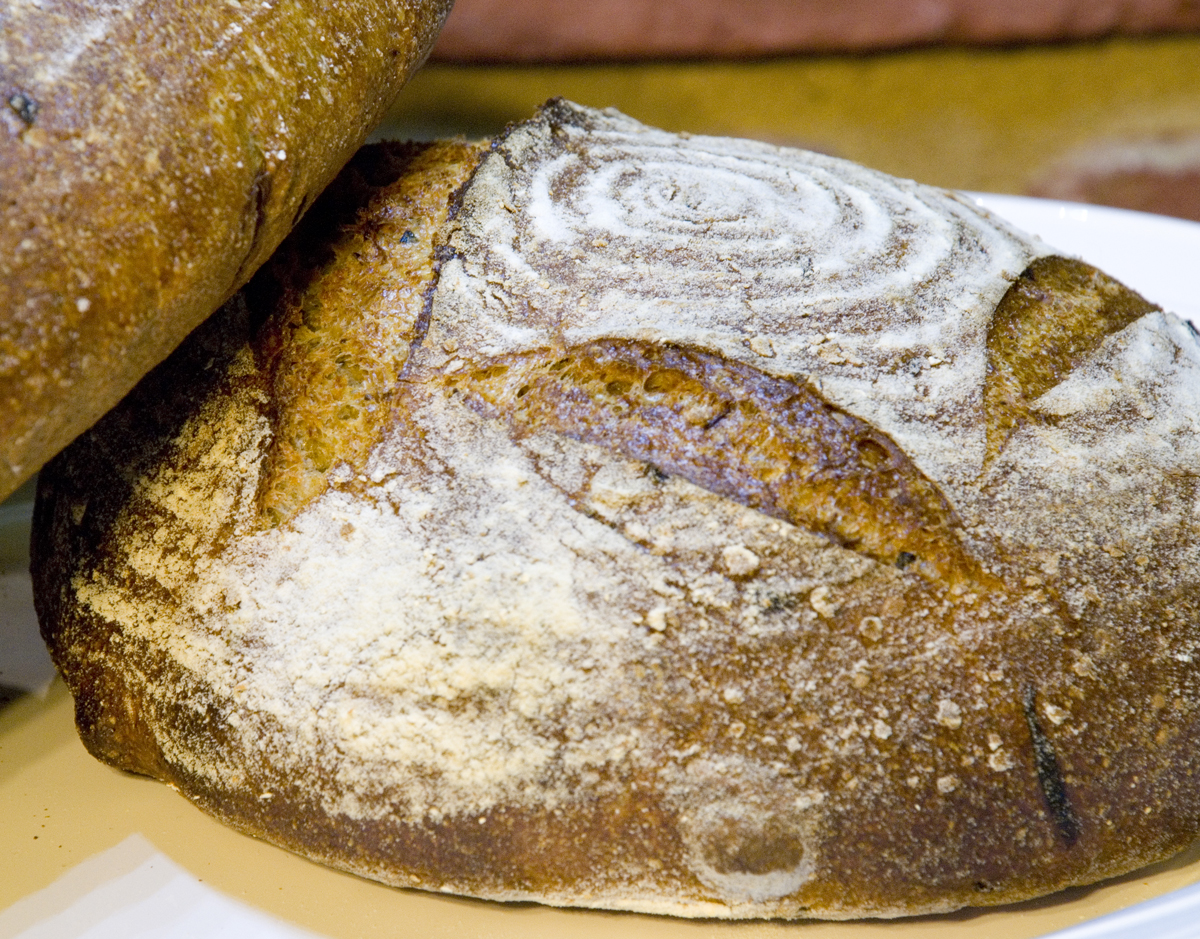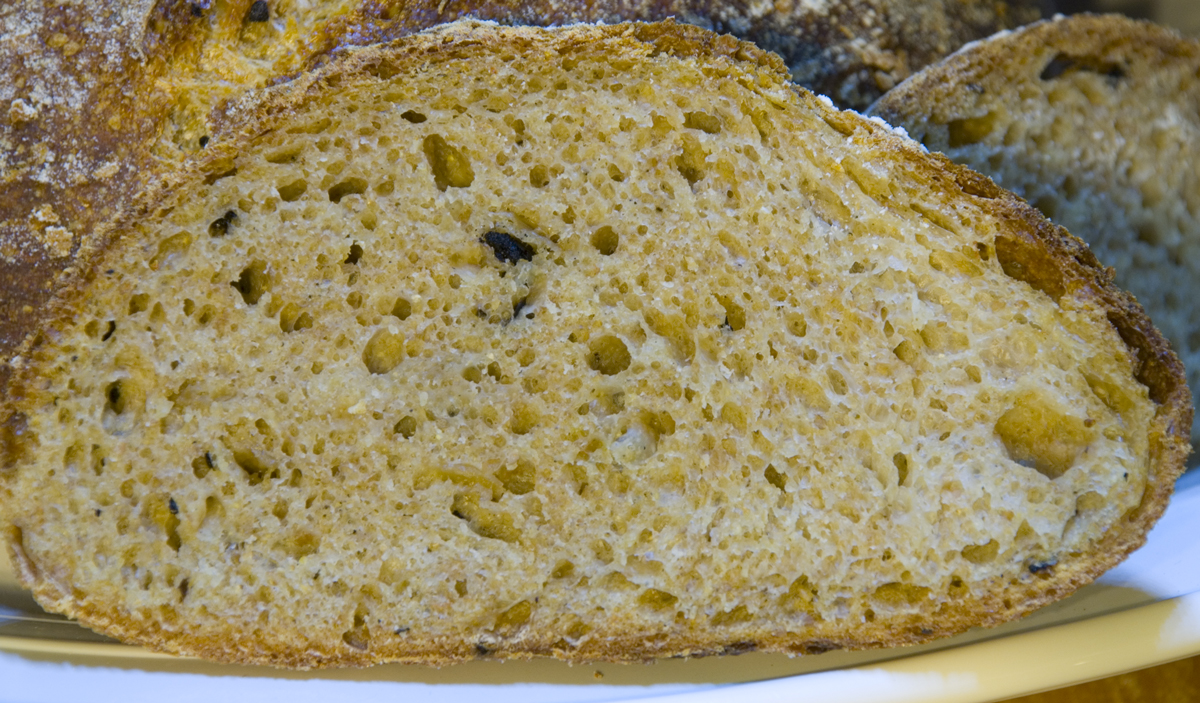
36 Hour Multi-Grain with Caramelized Onions Sourdough

I love using this 36 hour method to make bread. It takes a little planning but once you figure that part out it's pretty easy. I have yet to have a bad result from this method unless you count the baguettes that got stuck to my peel and fell into my oven, but we won't go there!
I actually baked this bread on Monday but since this week has been a blur due to me starting a new job on Monday and adopting a new apprentice on Sunday I've had my hands full!
Our new family member Lexi is around 4 months old and is a black Lab mix. She's keeping Max busy, that's for sure!
I love caramelized onions and wanted to use them in this bake along with some fresh milled hard winter white whole wheat, spelt and rye along with some KAF French style flour. Other than the different flours this one was pretty straight forward formula and the end results were perfect. The crumb is nice and open and the onion flavor was to die for. I mixed the onions in with the dough when adding the starter and salt and it had plenty of time to permeate the dough.
On another note, I signed up to be a test subject for BreadStorm for the IPAD and the formulas below are screen shots from my first attempt. I have to still learn how to use this program, but for the first try it seems great and worth a look if you like to turn your recipes into formulas. (Update: I switched out the original formulas for the corrected versions with the flour and water from the seed starter included).
Give this one a try and I guarantee you won't be disappointed.
Directions
Starter Build 1
Mix ingredients in a bowl until thoroughly combined. Cover the bowl and let it sit at room temperature for around 8 hours. The starter should almost double when ready to proceed.
Starter Build 2
Add to Build 1 Starter:
85 grams French Style Flour
52 grams Winter Hard White Whole Wheat
100 grams Water at Room Temperature (80-90 degrees F.)
Mix ingredients in a bowl until thoroughly combined. Cover the bowl and let it sit at room temperature for around 4 - 6 hours. The starter should almost double when ready to proceed.
Main Dough Procedure
Mix the flours and the ice water together in your mixer or by hand until it just starts to come together, maybe about 1 minute. Put the dough in a slightly covered oiled bowl and put in the refrigerator for 12 hours.
The next day add your starter, caramelized onions and salt to the dough and mix by hand until it is thoroughly mixed and evenly distributed. Due to the high water content in the 100% hydration starter this dough is very easy to mix by hand and is very silky and smooth.
Bulk rise at room temperature for 2-3 hours until it grows around 1/3 in volume doing stretch and folds every half hour until it has developed the correct amount of strength.
Put the dough back into the refrigerator for around 20-24 hours. I took it out about 20 hours later.
When you take the dough out of the refrigerator you want it to have almost doubled in volume, but if it doest don't worry as it will end up okay anyway. Let it rise at room temperature for around 2 hours or until the dough has doubled from the night before.
Next, divide the dough and shape as desired and place them in their respective basket(s).
Cover the dough with a moist towel and let sit at room temperature for 1.5 to 2 hours.
Score the loaves as desired and prepare your oven for baking with steam.
Set your oven for 550 degrees F. at least 45 minutes before ready to bake. When ready to bake place the loaves into your oven on your oven-stone with steam and let it bake for 10 minutes and then lower the temperature to 450 degrees. When the loaf is golden brown and reached an internal temperature of 210 degrees F. you can remove it from the oven.
Let the bread cool down for at least an 3 hours or so before eating as desired.








Comments
The 12 hr autolyse of all the flour appears again :) Works a charm on the silkiness of the dough as you say. I leave mine on the countertop which this time of year is 66-68. What do you find to be the difference with putting it in the fridge ? Love this bake gorgeous crumb. . What was the weight of each boule ? I am a little confused by the new format need to look at it further. c
Thanks for the comments. I really loved this one and will make it again for sure. I would say for this particular procedure it is probably important to really slow down the fermentation by putting it in the refrigerator. I find this develops more flavor or at least that is what its supposed to do. I would have to try it both ways to see what the difference is, but I as a rule of thumb always let my dough bulk retard in the refrigerator, but in this case it's a must do.
As far as the weight of each boule, it should be the total weight 1942 divided by 2. I'm still playing around with this program and as DA says below it didn't calculate the seed starter flour and water correctly.
Regards,
Ian
"Mix the flours and the ice water together in your mixer or by hand until it just starts to come together, maybe about 1 minute. Put the dough in a slightly covered oiled bowl and put in the refrigerator for 12 hours."
Was just referring to the extended autolyse...not the fermentation. I do the extended autolyse regularly now and have only done so in colder weather so wondering if you have any thoughts on that. As to fermentation , yes that I would do in the fridge. Thanks for your thoughts. c
Okay...sorry about that. This method was adapted from TxFarmer's 36 hour baguettes and by putting the flour and water mixture in the colder refrigerator I think it's supposed to help to make the dough easier to mix. I do find this method does seem to work very well, so I urge you to give it a go and see what you think.
Regards,
Ian
when she first came out with the 36 hr I tried the cold autolyse and all I had were lumps of cold dough interspersed with the levain. It was hell trying to get them mixed. That is why I have been doing my at room temp only...easy peasy to get them mixed. Will have to see what happens when I try it again. New things all the time. Thanks for explaining. c
I'm surprised as I've never had that problem. It's always been a breeze for me. Maybe you refrigerator was too cold?
Well, I hope you give it a try again with this formula and let me know if it works out better for you.
Ian
She couldn't go a better home wt lots of playmates and Max now has friend o help terrorized the 5 Feline apprentices and even the playing field.
2nd - you new program does not treat the flour and water in the starter amount correctly. There is 18 g of flour in your starter that is uaccoi8nted for and raises the total flour to1 169 not 1051. Hydration is 72.22%
Thirdly, your multigrain bread looks terrific as usual. Must be all the apprentices:-) Love the 356 hour method. The only problem is when i do it it always comes out to 40 hours:-)
Happy baling and Lucy says hit to th new Lexi, Max and the 5 felins apprentices
Appreciate your comments as always and glad you like this one. I really love the flavor and texture of this one.
We just came back from the dog park and Max and Lexie are pooped after chasing each other and all the other doggies for 2 hours. The kitties are not amused by Lexie, but they will learn to tolerate at eventually ;).
You are right about the formula and I already reached out to the inventor of the program for their advice. It is not calculating the flour in the seed starter or water.
I think you must have meant 36 hours and not 356 hours....I think that might be pushing the boundaries just a bit :).
Lexi would love to play with Lucy one of these days, but for now she will have to make do with just Max.
Look forward to your next bake.
Regards,
Ian
Very nice looking loaves Ian, and I like the combination of flours you're using as well.The crumb is lovely with it's open and even cell structure but am wondering if the pale yellow colour is actually present in the crumb or is that the lighting making it appear that way?
Congratulations on the new family member and kudos on your loaves, they both look great!
Franko
Appreciate your kind words. I think the color may have been off a little bit, but there is a slight yellow tinge to the crumb but maybe not quite as yellow as it looks. I may have bumped up the saturation too much...sorry about that :)
I was very happy with the way this one came out and wouldn't change a thing on it.
The new family member is adjusting well, but it's zapping my strength trying to keep up with her :).
I really enjoyed your last post as well and have to catch up and comment on it next. I started a new job, bought a new computer (IMAC) and got a puppy all in the same week!
Regards,
Ian
Your breads look really good, Ian.
When I have incorporated sautéed onions in bread, the onion flavor didn't come through much. That was a 40% sour rye. How do the onions taste in your bread. I love the idea, as I imagine them.
David
Thanks David.
Always appreciate your feedback.
The onions really came through great on this one. I've added them to the starter of one of my rye breads and that really did the trick. For this one the long overnight bulk retard does the trick. Give it a try sometime and let me know if it works for you.
Regards,
Ian
I like how your breads turned out, Ian. They must taste superb!
At work, i can't see pics you link from your blog. I'll see the formula and the crumb pics when i get home.
All the best!
Thanks Khalid. You would like the taste of this one. I'm having some now with a feta cheese Omelet and it's really good. Look forward to your next post.
Regards,
ian